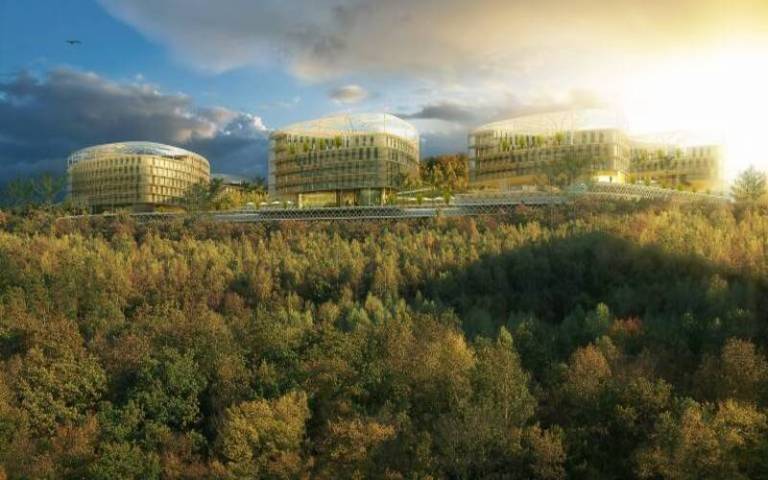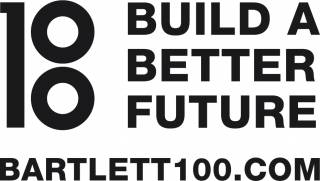Nature and Healthcare Design
24 October 2019, 9:00 am–5:00 pm

Nature and Health are interlinked. In design practice though, they often end up in different silos. This short course aims to bring them together by gathering UCL and UK academics with distinguished international practitioners.
Event Information
Open to
- All
Organiser
-
Bandana Rehncy020 3108 8162
Location
-
UCL Here East, 1st Floor8 - 9 East Bay Lane, Queen Elizabeth Olympic ParkLondonE15 2GWUnited Kingdom
About
Biomimicry has been hailed as a powerful creative and intellectual tool which catalyses innovation through the of appropriation and deployment of ‘natural’ intelligence. From engineers to architects, from inventors to urbanists, designers and thinkers from all fields have been inspired by the biological world since time immemorial.
How do we allow our inspiration to be channelled, given that the inspirational starting point of the biologist and artist is often remarkably similar and yet their results are so disparate? How do we identify the relevant aspects of living systems with respect to healthcare facilities? The answer lies in the development of method, and the workshop’s participants are asked to marry unbridled intuition with intellectual rigour.
The course is run by the Bartlett Real Estate Institute UCL and offers great networking opportunities.
Course content / Structure of day
9.00am - 9.30am: Opening, coffee and networking
9.30am - 10.15am: ‘Introduction on the day’ by Dr Evangelia Chrysikou (Lecturer - Program Director)
10.15am - 11.30am: ‘Biomimicry: learning from the living’ by Steven Ware (Architect – Partner Art&Build Architects)
11.30am - 12.00pm: Visit to the Bio-ID Lab
12.00pm - 13.00pm: Lunch break and networking
13.00pm - 14.30pm: ‘Biomimicry: learning from the living: the workshop’ by Steven Ware and Coen Van Den Wijngaart (Architect - Business Development Manager Art&Build Architects)
14.30pm – 15.00pm: Break
15.00pm - 16.30pm: ‘Biourbanism: patterns of human-centred design for healthy environments in resilient future cities’ by Dr Eleni Tracada (Senior Lecturer in the Built Environment, University of Derby)
16.30pm - 17.00pm: Key messages – Closure
Note: The exact times of the structure of the day may change slightly.
Course Overview
- Biomimicry: learning from the living
Steven Ware will lead off the day by presenting a resumé of how biomimicry has been employed by designers throughout history, and how we might come to a useful definition of biomimicry in light of today’s challenges and practices. He will outline design work across a wide range of architectural and urban scales, both addressing a concern to improve selected aspects of sustainability, from carbon footprint to life cycle analysis, all the while improving the quality of life for building occupants.
- Biomimicry: learning from the living: the workshop
Teams ideally composed of three students to facilitate exchanges and cross-pollination of ideas and interpretation of themes.
The teams first individually identify a biophilic subject of their choice (plants, views, materials, etc.) Perceived barriers to the integration of such elements are first examined. Research (on line or other) is then undertaken to identify existing scientific studies on the biophilic subject chosen.
Specialists in the field of biophilia provide additional examples of applied biophilic design, considering benefits, barriers and new possibilities.
The workshop seeks to develop and reveal links between the ‘constructed’ world of the healthcare facilities and the benefits of nature, present through materiality, through systemic function, or through representation. Living entities are to be understood more thoroughly, their integration into an architectural or urban context tested, leading to a new vision of the ‘natural’ and ‘designed’ world, and questioning the polarity commonly conceived as which dividing and separating nature and architecture.
- Biourbanism: patterns of human-centred design for healthy environments in resilient future cities
Biourbanism endorses principles of geometrical coherence, Biophilic design, BioArchitecture, Biomimesis, etc. in practices of design and also new urban policies and, especially Biopolitics, to promote urban revitalization by ensuring that man-made changes do not have harmful effects to humans. Green city standards start inside the designs of each building and continue either in unbuilt spaces surrounding buildings or inside complex infrastructural networks, connecting buildings and people.
New exciting developments recently, such as fractals, complexity theory, evolutionary biology and artificial intelligence are interrelated and constantly stimulate interaction between human beings and the surrounding built and unbuilt environment. Biourbanism considers the city as a living organism and recognizes optimal forms defined at different scales (from the purely physiological up to the ecological levels) which, through morphogenetic processes, secure an optimum of systemic efficiency for the quality of life of the people living in cities. Designs, which do not follow laws of nature, may produce anti-natural and hostile environments, which do not fit into human beings’ evolution, and thus, fail to enhance life by any means (Tracada & Caperna, 2012).
Research findings (Tracada, 2008) demonstrated that patterns of energetic lines, such as preferential paths, flowing and exploding in urban landscapes, had kept intact their evolving energy for many centuries and performed as generators of further expansion and development. These lines have always behaved as fractal everlasting emergences influencing and informing human behaviours in cities. Often these lines developed inside healing spaces or supported human interaction and well-being in the built environment.
Who this course is for:
The course is for a mix of professionals and students with an interest in environment and health and of multiple backgrounds: architects, designers, engineers, facility managers, healthcare planners, healthcare professionals, healthcare managers with an interest on healthcare buildings. Professionals of the care home sector might also find the course interesting as well as people working for capital planning and facilities and estates of the NHS.
- Learning outcomes
By the end of this one-day short course, you will:
- Have an introduction to design methods that draw inspiration from nature, i.e., biophilia, biomimicry, biourbanism
- Acquire a broader understanding of how biophilic design can influence buildings for health and healthcare delivery
- Get a glimpse of the potential of design and architecture but also the challenges /opportunities for healthcare facility designers
- Get an overview of the potential of biophilic design and end-user experience
- Have a general overview of European healthcare buildings and especially the Benelux context
- Interact and network with leading professionals, people commissioning projects and academics from multiple-disciplines and gain a multiple perspective on the subject.
Soft outcome:
- Increase your understanding on working across sectors and collaborating with different disciplines
- Learn how to interact across sectors and increase your networking skills.
As a short course student you won't be formally assessed, but you're expected to fully participate in group work. You'll receive a certificate of attendance on completion of the course.
Course team
- Dr Evangelia Chrysikou - Course leader
Medical architect, Lecturer (Assistant Professor) at the Bartlett Real Estate Institute, UCL in London. Program Director of the MSc Healthcare Facilities. PhD on mental health facilities from UCL and former Marie Curie H2020 Fellow. Actively involved in policymaking, Coordinator on D4 Action Group of the European Innovation Partnership on Active and Healthy Ageing (EIP on AHA) of the European Commission (EC) and consultant, on behalf of the EC, to the Hellenic Ministry of Health and the Centre of European Constitutional Law on legislation regarding mental health facilities. Received prestigious international awards (Singapore 2009, Kuala Lumpur 2012, Brisbane 2013, Birmingham 2014, London 2014, Vienna 2017, London 2019). Research on mental health, ageing, accessibility and mental health, autism, social inclusion, healthcare, welfare and wellness facilities, medical architecture, medical tourism planning spans in several countries of the world (UK, France, Belgium, Greece, Middle East, Japan, New Zealand etc.). PI at a Butterfield award of the Great Britain Sasakawa Foundation and CoI at a Marsden Fund from the Royal Society of New Zealand. Authored the books ‘Architecture for Psychiatric Environments and Therapeutic Spaces’ & ‘The Social Invisibility of Mental Health Facilities’, a healthcare architecture editor, reviewer, active member of several professional and scientific associations and a TED-MED speaker. Member of the Board at the Scholar’s Association Onassis Foundation.
- Steven Ware
Steven is an architect and trained biologist. He has dedicated his design work to the application of bio-adaptive principles to buildings and objects, notably the Groupe Chèque Dejeuner headquarters near Paris which won the international MIPIM award for Best Building Centre in 2011. He has designed and managed a series of projects which push the boundaries of environmental practice, winning a recent competition for the tallest residential timber tower in the world in Bordeaux. Other breakthrough timber projects include the headquarters of Paris’ architectural services (DCPA), completed in 2017 - the city’s first, large scale wooden framed office building - with other benchmark timber buildings in progress in Nantes, Paris, Brussels and Luxembourg. Steven heads up Art&Build’s think tank AB_Lab whose teams work with scientists, industrialists and research groups to integrate biomimetic concepts into mainstream construction practices, particularly in the health sector.
- Coen van den Wijngaart
Coen is an architect. As Art & Build’s business development manager he explores new partnerships and models which bring added value to projects through social integration, ecological responsibility and innovative spatial strategies. Business development implies the establishment of conceptual scales and strategies from the earliest stages of project development. By means of collective intelligence he explores collaborations with complementary partners from industry to academics and from engineers to fellow designers, all with the same mindset and commitment to innovation. Coen is co-author of the abstract “the Hospital a Living Organism”. A specialist in healthcare planning and passionate about high quality architecture, he has been involved in multiple hospital developments in The Netherlands, Belgium and France. At present, he is involved in the PPP development of SANAPOLIS, a health(care) campus with a focus on prevention and integrated care which will become a new benchmark for the Benelux nations.
- Dr Eleni Tracada
Eleni is Senior Lecturer in the Built Environment (Architecture) at the University of Derby, UK; Chartered Member RIBA Part III; Senior Fellow of HEA. She graduated in architecture, Faculty of Architecture of Florence, Italy (1980) and worked as a self-employed architect in Florence (1983-1993). MA in Interior Design at Manchester Metropolitan University (1996) and a PhD by Published Works at the University of Derby (2015). She taught Interior Design at Leeds College of Art & Design, Leeds (2001-2007). Member of the Scientific Committee of the International Society of Biourbanism; Editor in Chief of the Journal of Biourbanism (2011-2014). Main research interests include architecture, human behaviours in urban spaces, architectural psychology and placemaking, ageing and vulnerable communities’ needs in accommodation and urban design, gender issues, social justice and regeneration of neighbourhoods. Currently involved in activities within the Nature Connectedness Research Group at the University of Derby.
 Close
Close


 This event is part of Bartlett 100, a year-long celebration in 2019 to mark 100 years since the naming of the faculty.
This event is part of Bartlett 100, a year-long celebration in 2019 to mark 100 years since the naming of the faculty.